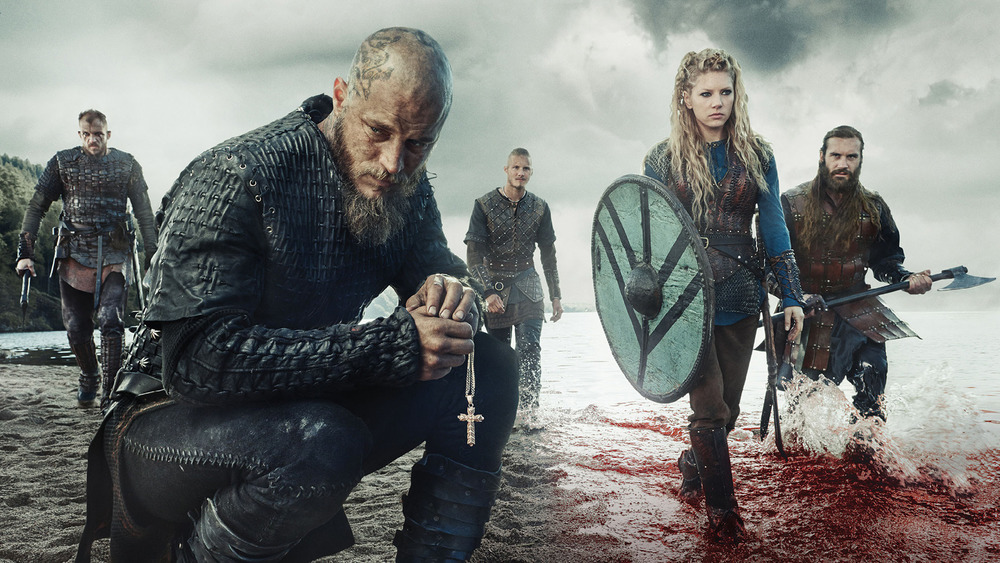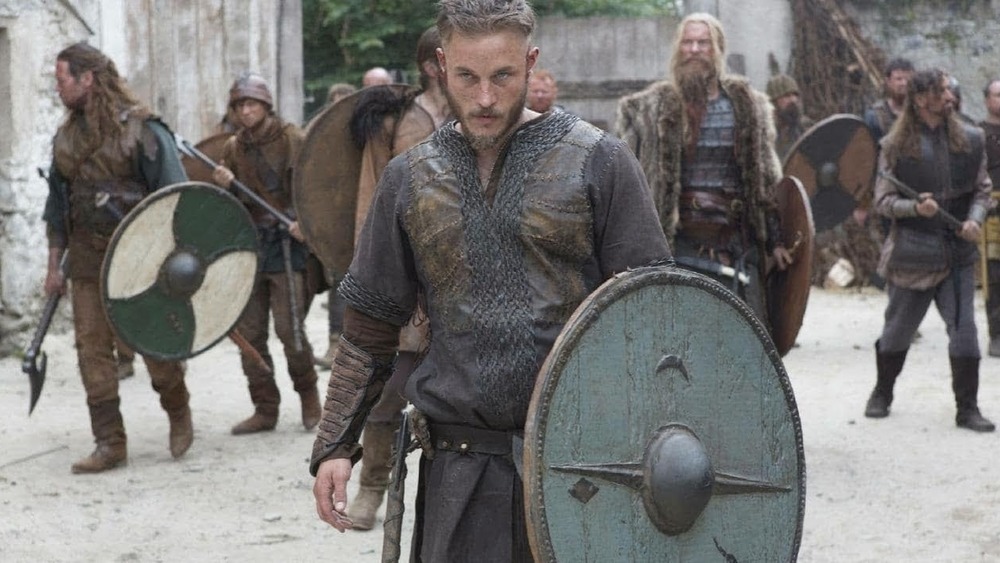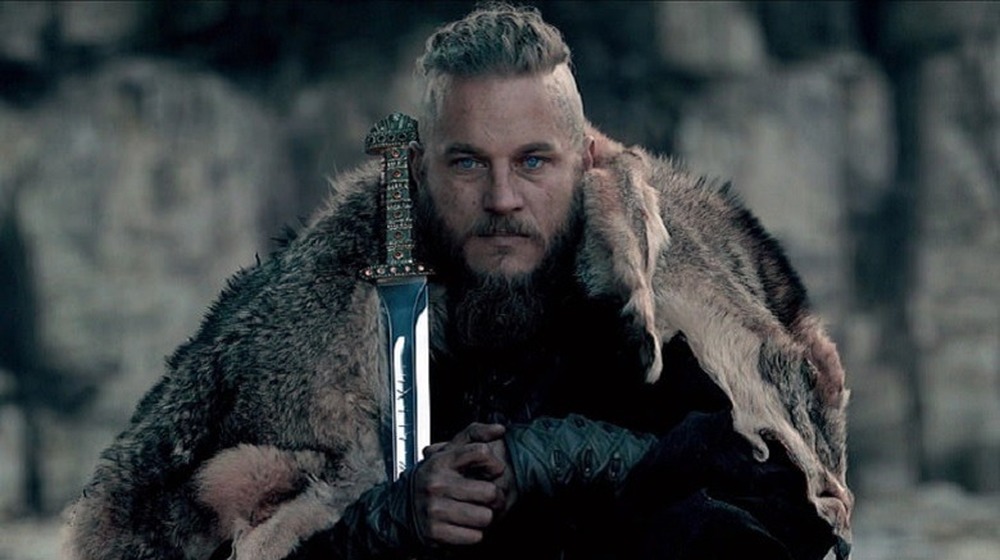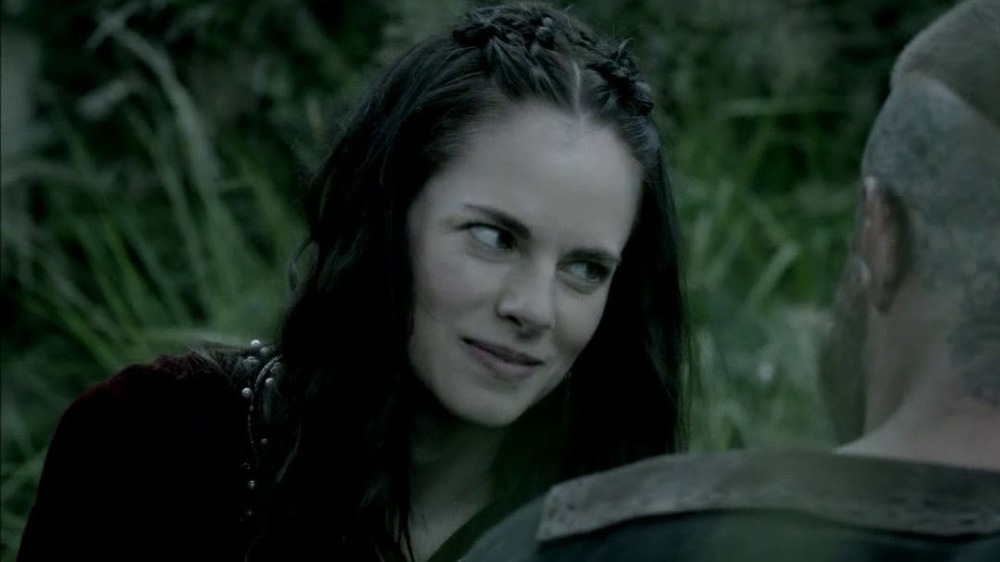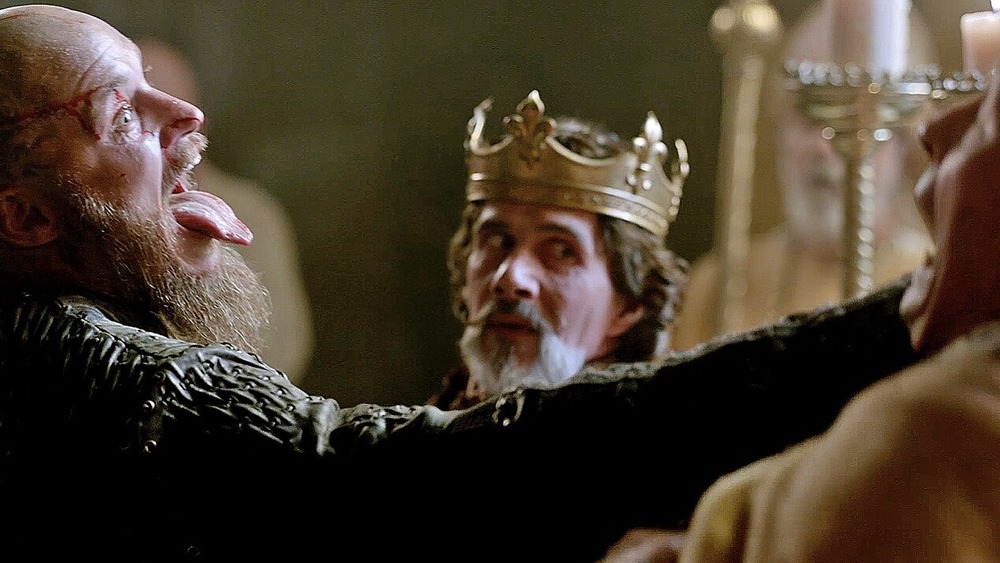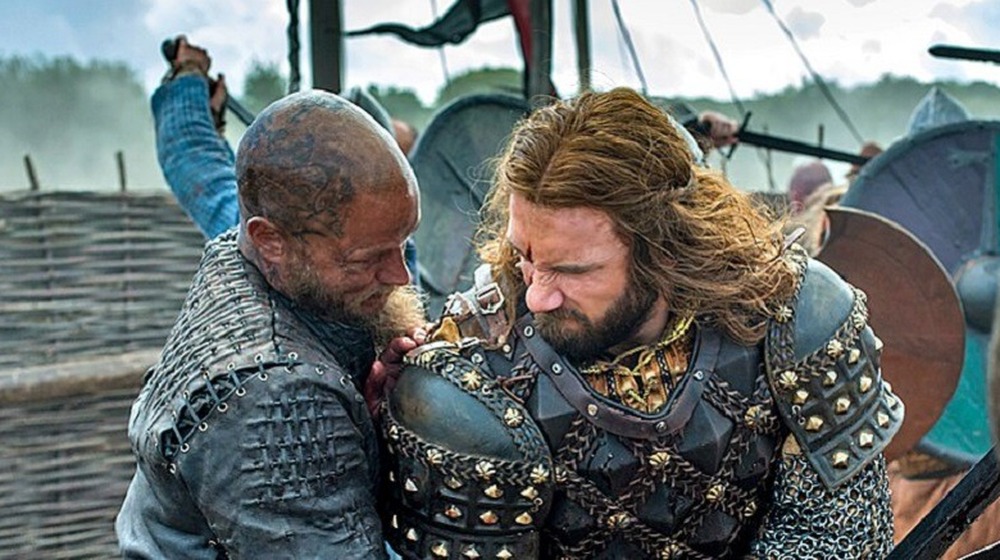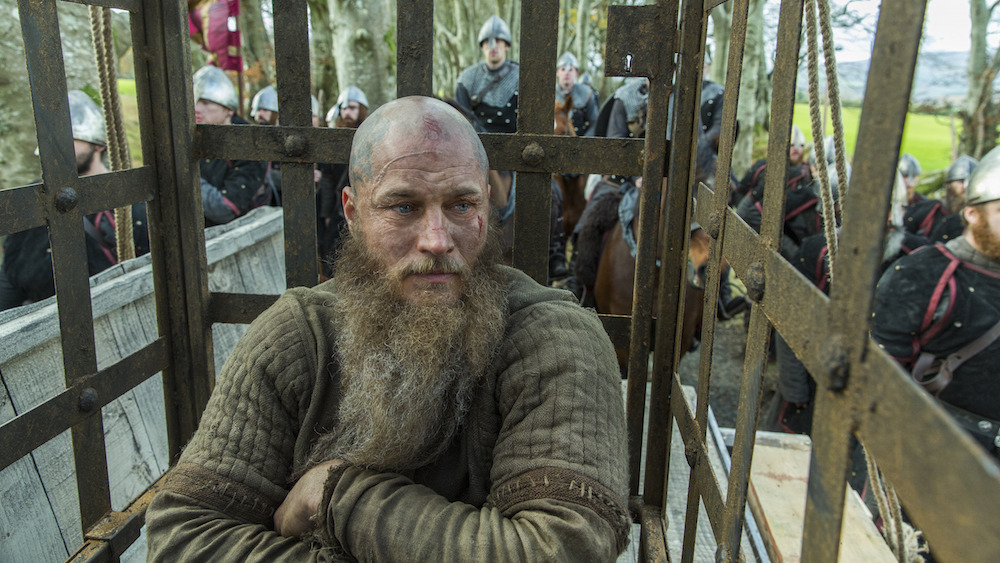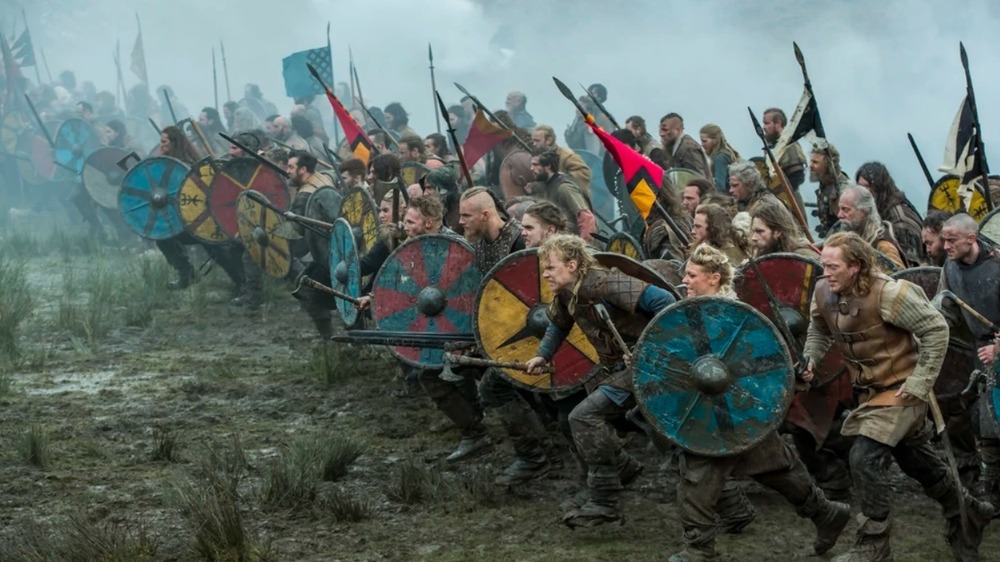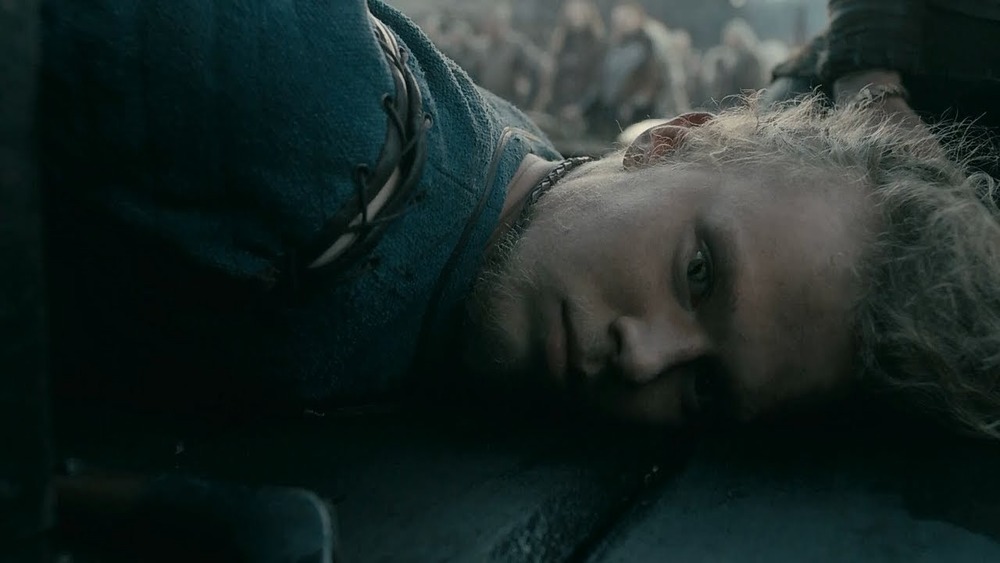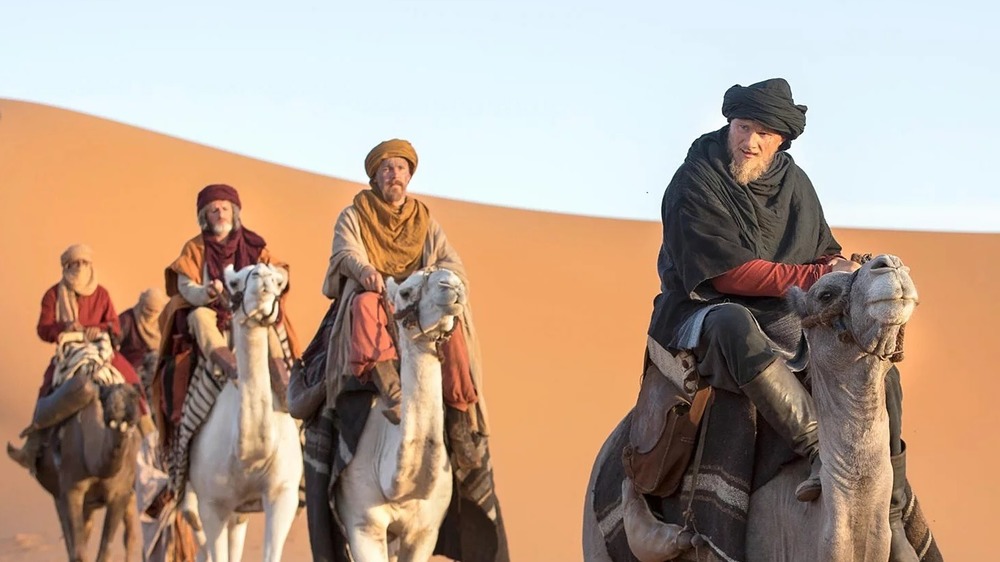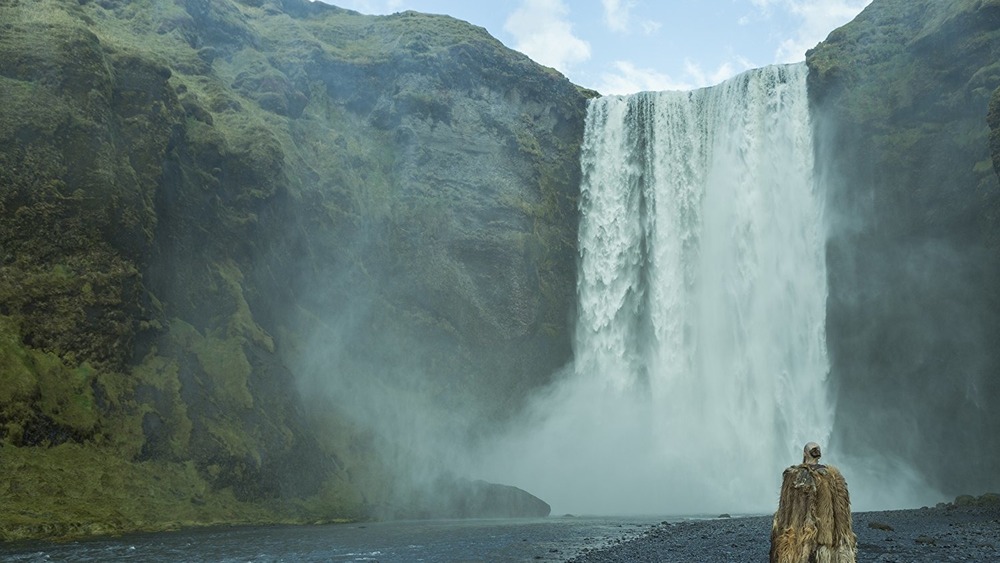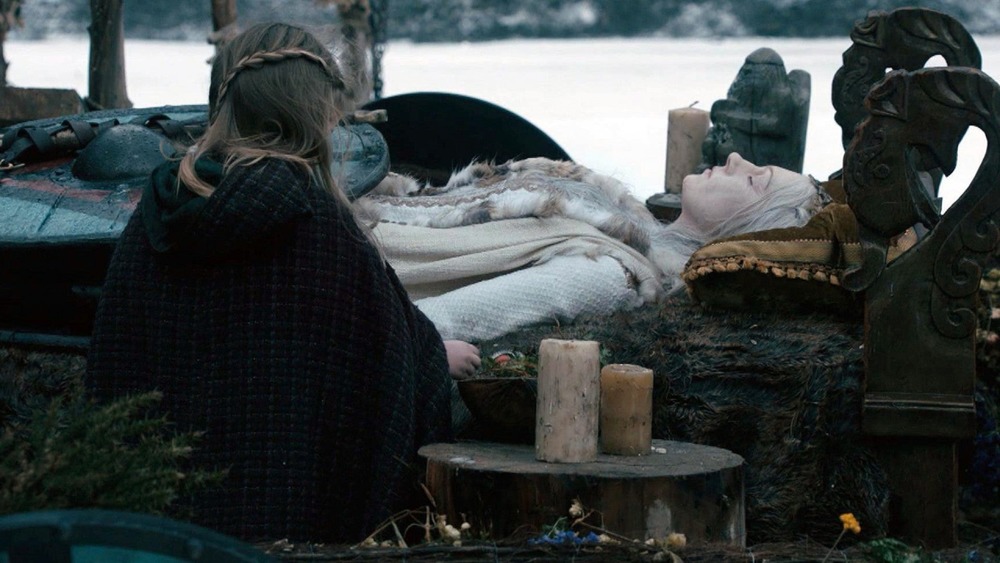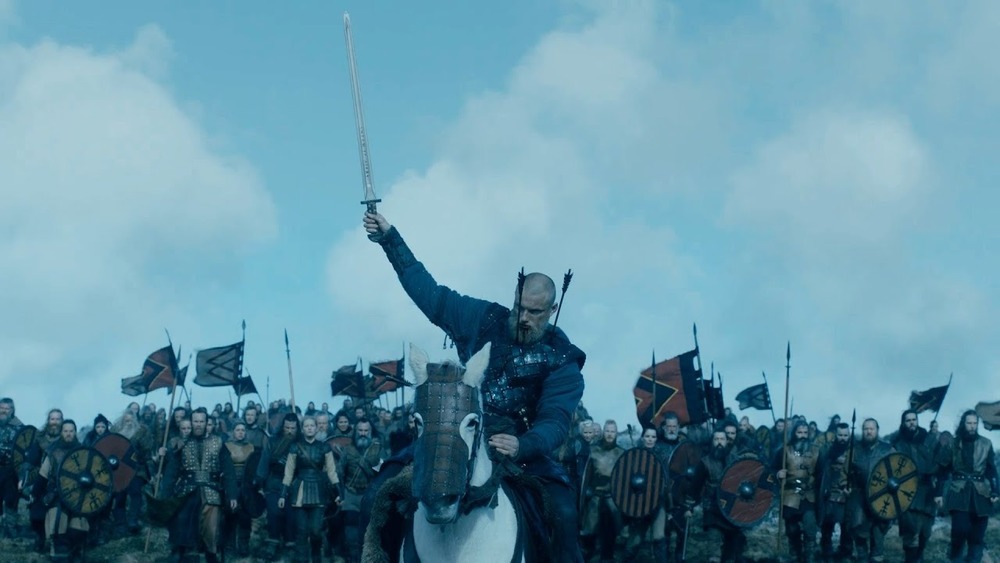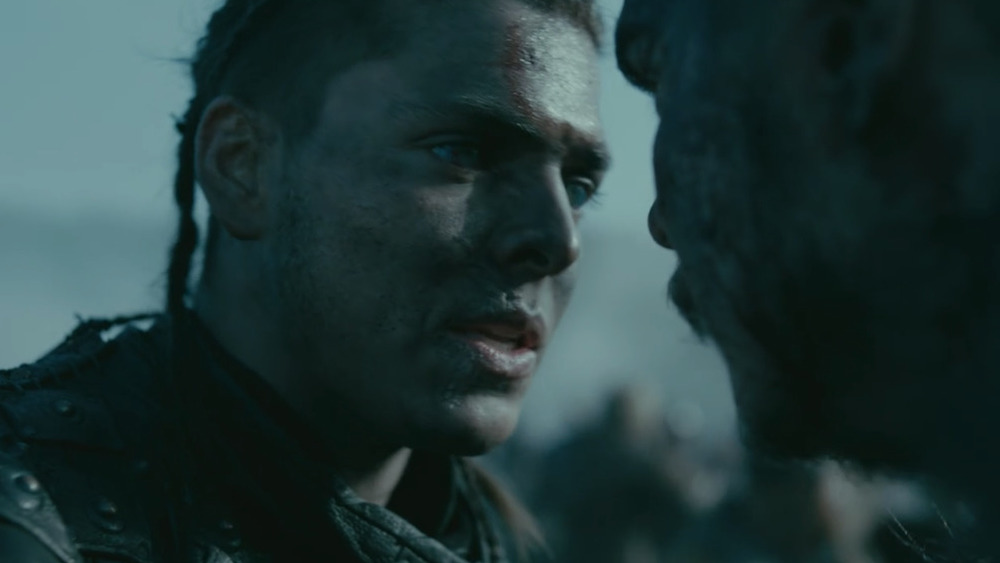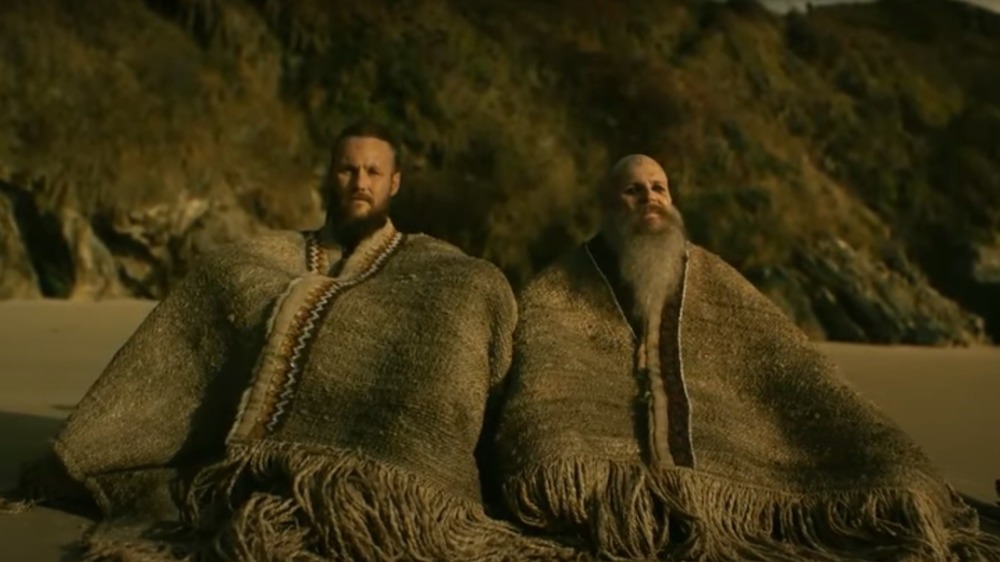The Entire Vikings Timeline Explained
When History announced a new series inspired by the sagas of Viking legend Ragnar Lothbrok in 2012, Collider claimed that creator Michael Hirst was "hoping to bank on the success of HBO's Game of Thrones." By the time the final ten episodes of Vikings dropped on Amazon Prime in December 2020, the show had long since established itself as much more than a cash-in attempt. Anchored by the charismatic Travis Fimmel, History's first scripted series was met with critical acclaim across the board. It quickly earned itself a dedicated following, and fans stuck around when Bjorn Ironside (Alexander Ludwig) and the rest of Ragnar's sons took the lead following his death.
Vikings unfolds over a period of decades, though in reality, some of the events it's based on happened centuries apart. "You have to give dramatic shape to stories, even if those stories are very close to the historical record," Michael Hirst told Looper in an exclusive interview. "It was called the dark ages for a very good reason — a lot of things were not written down at the time." He used some artistic license when it came to filling in the gaps, cramming the full story of the Viking age of exploration into just 89 episodes. A whole lot happened over the course of the show's six seasons and keeping track of dates can be a little tricky, which is why we're breaking down the entire Vikings timeline. Here's how (and when) it all went down.
Ragnar raids Lindisfarne and begins the Viking-Saxon wars
We know that the first major onscreen event in Vikings happened in 793, because it's based on an actual raid that took place that year in history. The first real-life Viking attack on Anglo-Saxon soil actually unfolded four years earlier, when three longboats landed on the coast of Wessex and murdered's the king's reeve, but this raid was on a different level. When a band of bloodthirsty Vikings plundered St. Cuthbert's Church on Lindisfarne (also known as Holy Island on account of it being the epicenter of Celtic Christianity) and slaughtered the defenseless monks they found there, they "sent shockwaves through Europe," according to English Heritage. That's exactly what happens on History's Vikings, though in the TV show, the Lindisfarne raid is led by Ragnar Lothbrok.
A simple farmer with lofty ambitions, Ragnar gained the respect of his people by uniting them with a common cause. When he returned from England with foreign riches (and a monk slave who would later become a trusted friend), interest in returning to the Saxon kingdoms was high, but Ragnar's chieftain Earl Haraldson (Gabriel Byrne) wasn't thrilled. With Ragnar's popularity on the rise, Haraldson attempted to have him killed. When his assassination attempt failed, he accepted Ragnar's offer of a duel to the death, which, of course, he lost. Armed with the knowledge he gained from his Christian captive Athelstan (George Blagden), Ragnar began organizing a large-scale attack, and the age of the Viking-Saxon wars began.
The reign of King Ragnar begins
Ragnar sailed westward again around the year 800, this time with the aid of his last remaining superior, King Horik of Denmark (Donal Logue). Their combined forces landed further south this time, coming ashore not in Northumbria (where Ragnar had already been paid a sizable sum to leave), but in the kingdom of Wessex. Their plundering of the monastery at Winchester quickly got the attention of King Ecbert (Linus Roache), who was eager to speak with Ragnar. When the ruler of Wessex discovered that Ragnar simply wanted to create a farming settlement for his people, they got to talking terms, but discussions were derailed when Ragnar received word that Jarl Borg (Thorbjørn Harr) had attacked his home, Kattegat, in his absence.
Dealing with Jarl Borg wasn't exactly straightforward (Ragnar lost a lot of men on the voyage home), but he ultimately outsmarted the Swedish usurper with the help of his former wife Lagertha (Katheryn Winnick) and now-grown son, Bjorn. His elation was short-lived, however — Horik soon arrived with his tail between his legs, informing Ragnar that Ecbert attacked the fledgling Norse settlement after he left. With Lagertha's help, Ragnar and Horik returned to Wessex, though the latter's increasing paranoia over Ragnar's natural leadership cost the Norsemen the battle. The king attempted to have Ragnar killed upon their return, but loyal friend Floki (Gustaf Skarsgård) tipped him off and he dispatched of Horik in brutal fashion, taking the crown for himself.
Did Ragnar have a secret son with Princess Kwenthrith?
The newly crowned King Ragnar returned to Wessex in around the year 803, ready to reopen a dialogue with the Saxon kingdom's learned leader and secure some rich farmland for the people of Kattegat. Ragnar's prisoner-turned-trusted advisor Athelstan had him well-versed in the ways of Christianity by that point (he was in the middle of learning the Lord's Prayer when Horik launched his ill-fated assassination attempt), and he would ultimately form a bond with Ecbert based on mutual respect. In order to seal his resurrected alliance with Wessex, Ragnar was tasked with helping Ecbert's ally, Princess Kwenthrith (Amy Bailey), take the crown of neighboring kingdom Mercia from her uncle.
As the most sexually charged character in the show by far, it seemed inevitable that Kwenthrith would try it on with the blue-eyed Viking. We didn't actually get to see them do the deed, and that's because the actors decided it would be better to sow some mystery instead. "There was a sex scene but Travis [Fimmel] and I talked them into cutting that out because we thought it would be more interesting as people don't know if [her son] Magnus is his or not," Baily told Beauty is Eternal, but that wasn't the only reason. She added: "Nobody wants to do sex scenes."
Ragnar never recognized Magnus (Dean Ridge) as his son, but nobody could doubt his dedication to the Viking cause — he would later die defending Kattegat from attack.
The Siege of Paris was Ragnar's finest hour
Spanning the eighth, ninth and tenth episodes of Vikings season 3, the Siege of Paris was based on a series of actual events that took place in the mid-to-late 9th century. According to Britannica, the first recorded Viking attack on the Frankish capital took place in 845, when a bunch of Norsemen snuck up the Seine on longboats and began an assault on the city. In History's Vikings, the first siege was brought forward to the start of the century (around the year 804, going by character ages and the changing seasons), and it made for one of the most engrossing battles of the entire series.
A challenge like nothing they had faced before, Ragnar and his huge Viking fleet (the king had six different earls with him, Lagertha included) struggled to breach the walls of Paris, an island city at the time. Both he and his son Bjorn suffered serious injuries, and it appeared as though Ragnar would succumb to his. He arranged a meeting with the Franks, but when they offered him gold, he refused — he told them he was dying and wanted to be baptized before he passed. Ragnar requested that he be buried in the city, and his relieved enemies agreed, which, of course, was a terrible mistake. The sly Viking king leapt from his coffin once inside the city's cathedral, slaying the bishop of Paris in front of the terrified Emperor Charles (Lothaire Bluteau).
Ragnar's return to Paris didn't go to plan
It was Ragnar's cunning that led to the successful sack of Paris, but when he returned to the Frankish stronghold a few years later (approximately 806 in the show's timeline), he came up against a formidable foe in the form of his own brother. Rollo (Clive Standen) volunteered to stay behind and keep charge of a Viking camp near Paris after the first raid, and when Ragnar returned home for the winter, Charles decided to reach out. The meek emperor offered Rollo land, riches, and his daughter's hand in marriage if he switched sides and protected Paris from further raids. Having already caught a glimpse of Princess Gisla (Morgane Polanski, daughter of Roman) during the siege, Rollo gladly accepted the emperor's terms, something his bride to be was far from thrilled about.
Rollo had a very hard time winning the headstrong princess over, though his actions during the Second Siege of Paris proved where his loyalties lay. The converted Norseman used his knowledge of Viking warfare to prepare the city for an attack, urging the Franks to build more ships. Ragnar's rabid forces quickly gained the upper hand, but the battle took a turn when Rollo killed one of his own soldiers for cowardice and delivered an inspiring speech to his shaken men. The Vikings were forced to retreat, and Rollo returned to Paris as a hero. A defeated and shamed Ragnar sailed away and began his years of exile.
Ragnar's final voyage west
Ragnar Lothbrok vanished for years after his humiliating loss to the Franks. When he returned to Kattegat around a decade after his disappearance, he was no longer the strong, fearsome warrior the Western world once knew him as, but it didn't matter — none of his sons were willing to fight him for the throne. He announced that he planned on returning to England, but none of his boys were interested in accompanying him, apart from Ivar the Boneless (Alex Høgh Andersen). Ragnar's crippled son was still living in the considerable shadows of his battle-hardened brothers at that stage, but this father-son trip across the North Sea would be the start of his journey to greatness.
The year was approximately 817 when Ragnar and Ivar arrived in Wessex, their fleet nigh-on decimated by storms. They were soon captured by Ragnar's old frenemy King Ecbert, who just couldn't bring himself to kill the famous Viking. Ragnar suggested that he be sent up to Northumbria, where King Ælle (Ivan Kaye) would deal with him. He convinced Ecbert that all he had to do was let Ivar go so he could tell of what happened, and his sons would then seek revenge against the Northumbrians, not Wessex. Ragnar was then carted off to Ælle, who tossed him into a pit of venomous snakes, bringing his reign to an end. His second wife, Aslaug (Alyssa Sutherland), met her end around the same time, murdered by his first wife, Lagertha.
The Great Heathen Army sets sail for England
A year after the Valkyries carried Ragnar off to Valhalla, his sons returned to England to exact their revenge on the man who killed him. Bjorn, Ivar, Ubbe (Jordan Patrick Smith), Hvitserk (Marco Ilsø) and Sigurd (David Lindström) arrived in Northumbria with a force of around 4,000 Vikings, overwhelming the underprepared Saxons. King Ælle was brought to the snake pit where Ragnar died and put to an even more horrific death by Bjorn. Ragnar's first-born subjected the king of Northumbria to the dreaded blood eagle, a grisly method of execution mentioned in Norse sagas that involves cutting open the back of a still-breathing victim and pulling the lungs out into the shape of wings. Historians are divided on whether blood eagles actually happened, but the Great Heathen Army was most definitely a real thing.
The Great Heathen Army arrived in England a few decades later than they did in the show, though Vikings follows the history relatively closely here. In real life, a coalition of Vikings from Denmark, Norway and Sweden led by the actual Ivar the Boneless "landed in the kingdom of East Anglia, where they met little resistance," according to Britannica. From here, they traveled overland to Northumbria, taking the capital city of York. King Ælle managed to escape this time, but he was either killed in battle or captured the following year. "According to some accounts, the vengeful Vikings subjected Ælle to a particularly gruesome torture-execution."
Ivar the Boneless commits fratricide in front of his brothers
When Ragnar's sons were done taking their bloody revenge on King Ælle, they had yet another Saxon monarch to attend to. King Ecbert of Wessex released Ivar on the condition that he return to Kattegat and explain that it was Ælle who executed Ragnar, not him. What Ecbert didn't know is that Ragnar had secretly instructed Ivar to seek revenge on him, too. The famous Viking knew he was a spent force, but he also knew that if he allowed himself to be killed by Saxons, his boys would come down on them with the force of Thor's hammer. It was "part of a larger and bolder strategy" according to Ragnar, and it worked: Ecbert took his own life after Ragnar's sons stormed his villa.
The Great Heathen Army had achieved its prime objectives at this stage, and those leading it wanted different things. Tempers began to flair as the sons of Ragnar discussed plans for the future in front of their people. Some wanted to stay and farm while others wanted to explore new places, but Ivar was determined to keep the great army together for more conquests. As he attempted to win the crowd over to his cause, his already strained relationship with Sigurd Snake-in-the-Eye reached its breaking point. Sigurd mocked Ivar for not being a "real man," and it was the last thing he did — Ivar killed him with a throwing axe, right in front of their brothers.
Bjorn Ironside crosses the Sahara desert
Bjorn had just set foot in Spain for the first time when he learned of his dad's death from Odin, who appeared to all five of Ragnar's sons in separate visions to break the news. The Mediterranean was the furthest that his people had ever been at that stage. With Ælle and Ecbert both dealt with, Bjorn returned to Southern Europe to fulfill his destiny. It was around the year 819 when his fleet arrived at Sicily. He agreed to work as a bodyguard to Byzantine admiral Euphemius (Albano Jerónimo), but when he learned that his new boss was under the command of a great Arab leader in North Africa, Bjorn became interested in him instead.
"I always knew the real Bjorn Ironside went into the Mediterranean and found himself in what is now Tunisia, on the edge of the Sahara," Michael Hirst told Entertainment Weekly. In Vikings, Bjorn and his companion Halfdan (Jasper Pääkkönen) traveled across the desert by camel caravan and were greeted by Emir Ziyadat Allah (Khaled Abol Naga), who seemed interested in trade. The Norsemen quickly discovered that he wasn't a man you crossed, however — when they sat down to feast with the emir, they realized that Euphemius was absent from the meal because he was the meal. Bjorn escaped from the cannibal warlord's camp under the cover of a sandstorm and sailed back to Kattegat to deal with Ivar, who had claimed the throne in his absence.
The gods lead Floki to the land of fire and ice
Floki was at the head of the Great Heathen Army alongside Ragnar's sons, and, like them, he needed a new adventure after avenging his old friend's murder. As Bjorn broke new ground in the Mediterranean and North Africa, the famous shipwright took a longboat in the opposite direction. He didn't have a specific location in mind, but he ended up discovering a whole new land — or so he thought. Floki had given himself up to the gods at this stage, so when he came ashore in what would become known as Iceland and set eyes upon the island's stunning natural wonders, he believed he had been led to Asgard.
Intent on settling in the land of the gods, Floki returned to Kattegat and recruited a group of intrepid travelers. He found new purpose as the head of the Icelandic settlement, but he became disheartened when infighting among the group led to a series of murders. He would eventually retreat into a cave on the island, convinced that he had found the gate to Helheim, Norse mythology's underworld. What he found was far worse — a cross. Floki was such a staunch believer in the old gods that he murdered Ragnar's monk friend Athelstan in cold blood, so when he came to the realization that Christians had already been on Iceland, he was borderline hysterical. The Viking was half laughing, half crying when the cave complex began to collapse on him.
The death of a shieldmaiden
After his travels around the Mediterranean and Sahara, Bjorn came home and set his sights on becoming the first king of all Norway. The idea was proposed by King Olaf (Steven Berkoff), who brought the country's rulers together so they could vote on who should lead the lot. Bjorn had it in the bag until King Harald (Peter Franzén) swooped in, cheating him out of the crown. This took place around 820, a terrible year to be Bjorn Ironside. It started out well enough (he managed to retake Kattegat from his brother Ivar, who fled to the east), but he lost the big election and his beloved mother was killed by his half-brother soon after.
The famous shieldmaiden Lagertha died in a manner unbefitting of her fierce reputation: Stabbed to death in a dark, muddy street by Hvitserk, Ragnar's most troubled son. Hvitserk developed a drug problem after the death of his lover Thora (Eve Conolly) at Ivar's behest. He was hallucinating badly when he murdered an unsuspecting Lagertha, mistaking her for Ivar in serpent form. "Her death is a huge tragedy," Michael Hirst told Entertainment Tonight. "I even cried when I was writing it." Kathryn Winnick praised the show's creator for giving her "such a great death and a funeral," but admitted that watching those events play out onscreen wasn't easy. "Seeing Lagertha transitioning over to Valhallah was a bittersweet moment in a lot of ways," she said during Comic-Con 2020.
The Rus come to reclaim their ancestral homeland
After being ousted from Kattegat by Bjorn, Ivar went into exile and spent time traveling the famous Silk Road. The Viking encountered all manner of people and cultures along the legendary trading route, which ultimately led him to Novgorod, seat of the Grand Prince of Rus, Oleg (Danila Kozlovsky). The Christian zealot was instantly intrigued by the exiled Norseman, and he would reveal to Ivar that he intended to reclaim his people's ancestral homeland in Scandinavia. In approximately the year 821, Oleg and Ivar marched on Tamdrup, home of King Harald. Despite their feud over the election, Bjorn turned up to help Harald defend his land, which turned out to be a fatal mistake.
The first part of the final season of Vikings came to an end with Ivar running a blade through Bjorn. It seemed like a wound that nobody could recover from, and that turned out to be the case, but before Bjorn died he donned his armor and inspired his people to victory one last time. When the Rus arrived at Kattegat, they assumed that its fearsome warrior king was dead. When Bjorn appeared on horseback and took three arrows to the body without falling, the terrified invaders started to believe he couldn't be killed. "He does something quite extraordinary at the end of his life," Michael Hirst told Entertainment Tonight. "He saves his country [...] and puts himself in the pantheon of the great heroes of the Vikings."
Ragnar's sons set out to complete the conquest of England
Ivar wrapped up his personal redemption arc when he freed young Rus prince Igor (Oran Glynn O'Donovan) from the grip of his maniacal uncle Oleg, but he still had professional ambitions. The people of Kattegat (now ruled by Harald, who was captured by the Rus but managed to escape) reluctantly welcomed him home, but Ivar found himself unable to settle knowing that there was still one Saxon kingdom left standing. He and Hvitserk convinced an equally bored Harald that taking Wessex was the only thing left for them to do, and so they set sail for England with a Viking army at their backs.
Alfred, the son of Ecbert's daughter and monk-turned-Viking Athelstan, was now running the show in Wessex. The real Alfred is the only English monarch to have been given the epithet "The Great," largely because his was the only Anglo-Saxon kingdom that withstood the Viking onslaught. History shows that he utilized cunning tactics and brute force to repel his Norse foes, but in the show, the war is won when a random West Saxon soldier pops up in front of Ivar and stabs him with zero resistance. Ivar's death baffled and angered fans in equal measure, but Alex Høgh Andersen said it "felt like the most natural thing in the world" during an interview with Entertainment Tonight. "I really wanted him to go out in a completely different way than everybody else," he added.
Ubbe risks everything to reach the Golden Land
According to History, Viking explorer Leif Eriksson likely made land in North America long before Christopher Columbus crossed the Atlantic. Norse sagas and archaeological finds suggest that Eriksson set out from Scandinavia some 500 years before Columbus was even born, arriving in the so-called New World in the year 1000. Eriksson is a main character in Michael Hirst's sequel series Vikings: Valhalla, but the showrunner "always planned" on visiting North America in Vikings. "I knew that the ending would be the discovery of America, and Newfoundland," Hirst told Collider.
In the show, it's Ubbe who led the first group of Viking settlers to North America. They stumbled across Greenland first, but Ragnar's son and his family fled the barely hospitable island amid a violent squabble over whale meat. It was roughly the year 821 when Ubbe finally set eyes on "The Golden Land," as traveling companion Othere (Ray Stevenson) tantalizingly described it. He lost his stepdaughter on the voyage, but Ubbe found a long-lost friend when he got there — Floki survived the cave-in and sailed to Newfoundland, making a home for himself among the accepting Natives.
Things almost went awry when a greedy Viking murdered an innocent local, but Ubbe put the offender to death and restored peace. The Vikings saga came to an end with Ubbe and Floki watching the sunset from a pristine American beach, discussing the gods and reminiscing about the man who started it all, Ragnar.
